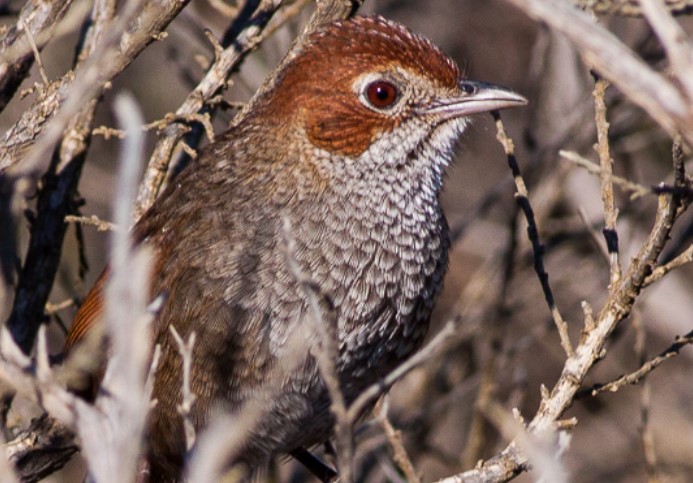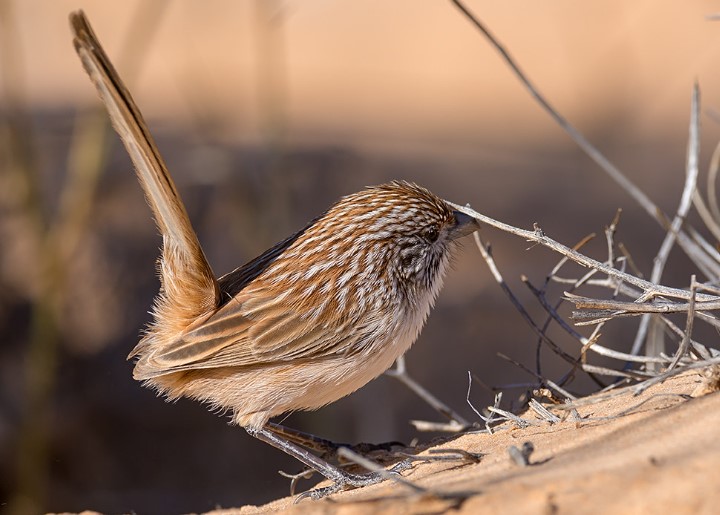Family: The Rufous Bristlebird (Dasyornis broadbenti) belongs to the family Dasyornithidae to the order Passeriformes.
Habitat: Subject to fires and the clearing of its coastal heaths, this species may now be extinct in southwestern Australia, where it has not been recorded since 1906. In the southeast, however, it is still moderately abundant in coastal dune scrubs of boobyalla Acacia sopharae and heath, mixed with pockets of sedge and paperbarks, blackberries, and forest undergrowth, between the Otway Ranges, Victoria, and the mouth of the Murray River.
Vocalizations: Rufous Bristlebird call is a loud, harsh tweak in alarm, often rapidly repeated; also softer alarm zit. The song is a clear, penetrating Pilotbird-like whistle of three or four pairs of quick, short upslurred or down-slurred notes, ending in a double whipcrack. The last three notes are often echoed by females in duets. This bird loudly signals, communicates, and sings to each other, uttering it round the year.
Behavior: Rufous Bristlebird is a ground-living bird; it rarely flies but runs with speed and agility through the undergrowth and beneath and around shrubbery. There it picks up its food—not only insects, beetles, moths, and larvae—but also seeds and berries, gleaned from both the seashore and shrubbery. When paused, the birds flare their tails. A Rufous Bristlebird with its two young Its song resembles a squeaking cartwheel. Established pairs occupy small territories that they advertise with year-round singing, perching low in small trees. Both sexes feed the chicks; only one may nest-build and incubate.
Diet: This bird mainly feeds small ground-dwelling invertebrates and seeds. Frequently, search for diet off the ground; also forage leaf litter or in short shrubs; collect insects or grubs; and eat terrestrial snails
Identification: Both sexes are similar. The head is russet brown; the back, wings, and long, bushy tail are olive-brown, grading to russet-brown over the rump. Lores and Malar lines are white. Throat and breast are scalloped deep gray and white; belly white; flanks olive-grey. The bill and feet are dark brown.
Nesting and Breeding: It occurs mainly in September and December. Large domed nest, with a platformed side entrance, of loosely woven rush and fine grasses and rootlets, in a tussock or small dense shrub, close to the ground.
Eggs: The bird lays two, often only one fertile egg; whitish, freckled heavily, and uniformly red and purplish; oval, about 27 x 21 mm.
Size: Rufous Bristlebird, similar in size to the blackbird, measures about 230–270 mm in length and weighs 77 grams.
Distribution: Rufous bristlebirds found from about Anglesea, Victoria, to Murray Mouth, South Australia, on the coast but ranging into the Otway Ranges. Also, southwest (extinct).
Races: There are two or three races.
-
Coorong rufous bristlebird (Dasyornis broadbenti broadbenti)
-
Otways rufous bristlebird (D. b. caryochrous)
-
western rufous bristlebird (D. b. litoralis)
Threats: habitat destruction due to coastal development. Predation and roadkill are another threat.







